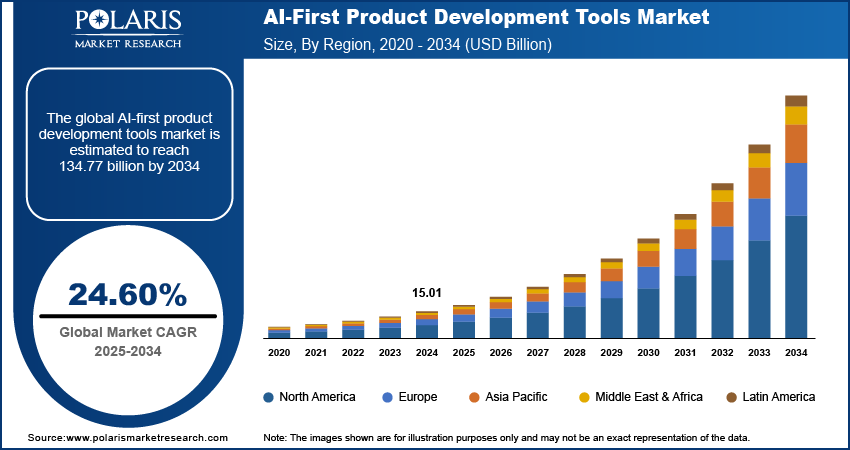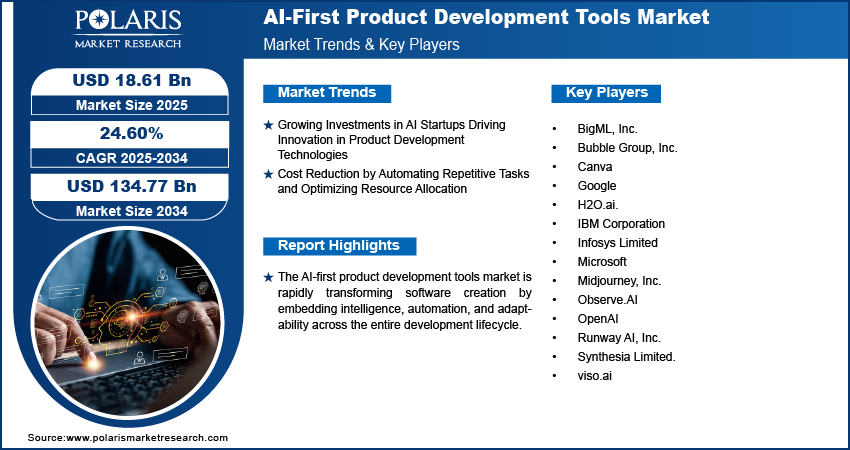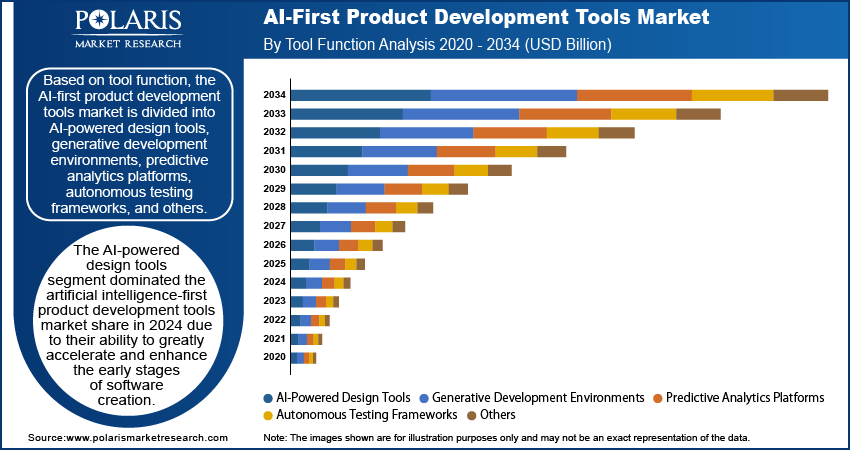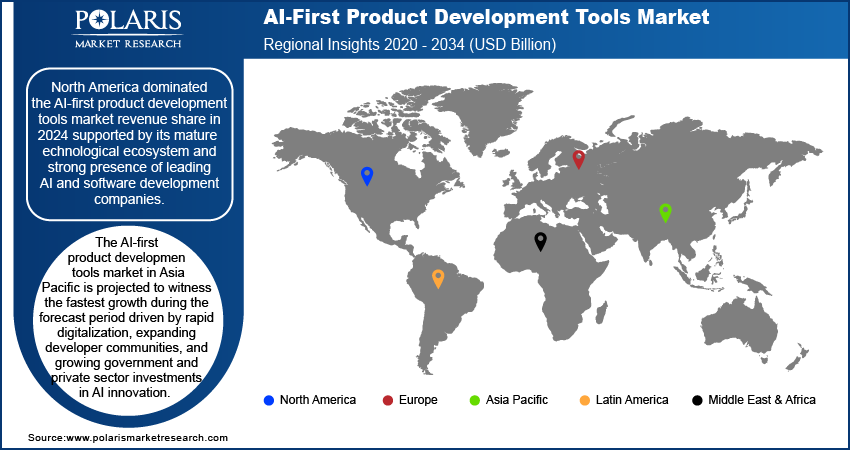
AI-First Product Development Tools Market Size, Share, Trends, Industry Analysis Report
: By Tool Function, Deployment Model (Cloud-Based and On-Premises), AI Capability Level, Industry Vertical, and Region (North America, Europe, Asia Pacific, Latin America, and Middle East & Africa) – Market Forecast, 2025–2034
- Published Date:May-2025
- Pages: 129
- Format: PDF
- Report ID: PM5593
- Base Year: 2024
- Historical Data: 2020-2023
AI-First Product Development Tools Market Overview
The global AI-first product development tools market size was valued at USD 15.01 billion in 2024. It is expected to grow from USD 18.61 billion in 2025 to USD 134.77 billion by 2034, at a CAGR of 24.60% during 2025–2034.
AI-first product development tools refer to a new generation of intelligent software platforms and frameworks that integrate artificial intelligence at the core of the product development lifecycle to automate, optimize, and accelerate various stages such as design, development, testing, and deployment. The increasing complexity of applications has boosted demand for tools capable of managing intricate workflows, codebases, and user requirements with precision and efficiency as the software landscape evolves. Traditional development tools often fall short in addressing the scale and variability of modern software products, creating a critical need for AI-first solutions that can streamline operations while ensuring high-quality outcomes.

To Understand More About this Research: Request a Free Sample Report
Automation and predictive analytics enable increased productivity and shorter time-to-market as these tools empower development teams to accelerate delivery cycles and make more informed decisions by leveraging AI code tools for real-time code generation, intelligent debugging, performance forecasting, and automation testing. A report by the AMA in December 2024 stated that a survey conducted in September 2024 revealed nearly 90% of marketers had used generative AI tools at work. Predictive models help anticipate development bottlenecks and optimize resource allocation, significantly reducing manual effort. This enables organizations to maintain agility, innovate faster, and stay competitive in an increasingly digital-first business environment. Thus, AI-first tools are becoming indispensable assets in driving operational excellence and strategic advantage across industries.
AI-First Product Development Tools Market Dynamics
Growing Investments in AI Startups Driving Innovation in Product Development Technologies
Growing investments in AI startups are driving innovation in product development technologies, which drives the AI-first product development tools market growth. For instance, in March 2025, an IBEF report revealed that India's USD 1.18 billion AI Mission will deploy 18,693 GPUs, create an open GPU marketplace, and strengthen domestic AI capabilities. It will also establish AI centers of excellence and a dataset platform to support startups, students, and researchers. These investments fuel the creation of innovative solutions that integrate advanced machine learning, natural language processing, and generative AI capabilities into development workflows. Startups, with their agility and focus on niche innovations, are accelerating the evolution of AI-first tools by introducing novel approaches to automate complex tasks, enhance user experiences, and scale software creation. As a result, the ecosystem is witnessing rapid technological advancements that empower enterprises to adopt smarter, faster, and more adaptive product development strategies.
Cost Reduction by Automating Repetitive Tasks and Optimizing Resource Allocation
The cost reduction is achieved by automating repetitive tasks and optimizing resource allocation through AI-first tools. These platforms enable organizations to minimize manual intervention in areas such as code generation, testing, debugging, and maintenance leading to substantial time and cost savings. For instance, in March 2025, Wipro launched TelcoAI360, an AI-powered managed services platform for telecom operators. The solution combines domain expertise with AI tools to reduce costs, automate workflows, enhance security, and accelerate service deployment while maintaining interoperability with existing systems and cloud environments. Furthermore, intelligent resource management ensures that development efforts are focused on high-impact activities, improving overall project efficiency and reducing operational overhead. AI-first tools support lean development models that align with modern business goals of scalability, agility, and fiscal prudence by eliminating redundancies and maximizing productivity.

AI-First Product Development Tools Market Segment Insights
AI-First Product Development Tools Market Assessment by Tool Function Outlook
The global AI-first product development tools market segmentation, based on tool function, includes AI-powered design tools, generative development environments, predictive analytics platforms, autonomous testing frameworks, and others. The AI-powered design tools segment dominated the AI-first product development tools market share in 2024 due to their ability to greatly accelerate and enhance the early stages of software creation. These tools use machine learning algorithms and generative AI to automate user interface design, suggest architecture patterns, and personalize user experiences based on real-time feedback and data inputs. AI-powered design solutions have become essential for enabling rapid prototyping and iteration as businesses prioritize speed and creativity in bringing products to market. Their integration into cross-functional development environments has made them indispensable, particularly in sectors demanding high design precision and faster release cycles.
AI-First Product Development Tools Market Evaluation by AI Capability Level Outlook
The global AI-first product development tools market segmentation, based on AI capability level, includes basic automation, advanced analytics, cognitive intelligence, and fully autonomous. The fully autonomous segment is expected to witness the fastest growth rate during the forecast period, driven by the increasing demand for end-to-end automation in product development. Fully autonomous tools leverage advanced AI capabilities to assist and independently execute development tasks ranging from code generation and testing to deployment and performance optimization. This level of autonomy reduces the dependency on human intervention, allowing organizations to operate with greater speed, consistency, and scalability. The transition toward fully autonomous systems is gaining substantial momentum as enterprises strive to minimize manual bottlenecks and adopt DevOps practices more efficiently.

AI-First Product Development Tools Market Outlook by Region
By region, the report provides the AI-first product development tools market insights into North America, Europe, Asia Pacific, Latin America, and the Middle East & Africa. North America dominated the AI-first product development tools market revenue share in 2024 supported by its mature technological ecosystem and strong presence of leading AI and software development companies. The region benefits from early adoption of AI-integrated platforms, a highly skilled workforce, and a strong culture of innovation across industries such as finance, healthcare, and technology. A report by the AMA found that weekly gen AI use among business leaders surged from 37% in 2023 to 73% in 2024. Additionally, a favorable regulatory and investment environment has accelerated enterprise-level deployment of AI-first solutions, particularly among large organizations seeking digital transformation. For instance, in 2025, Microsoft will invest USD 80 billion in global AI data center infrastructure, primarily for model training and cloud AI deployment. Over half of USD 40 billion is earmarked for US locations. These factors collectively position North America as a critical driver of market leadership across the world.
The Asia Pacific AI-first product development tools market in Asia Pacific is projected to witness the fastest growth during the forecast period driven by rapid digitalization, expanding developer communities, and growing government and private sector investments in AI innovation. In March 2025, the Ministry of IT and Electronics reported that 80% of Indian companies view artificial intelligence as a core strategic priority, surpassing the global average of 75%. Additionally, 69% plan to boost their tech investments in 2025, with one-third dedicating over USD 25 million to AI initiatives. Countries across the region are prioritizing technological advancement to remain competitive in the global digital economy, leading to increased adoption of AI-driven development tools in sectors such as manufacturing, retail, and healthcare. Furthermore, the region's dynamic startup ecosystem is fostering experimentation with AI-first technologies, while enterprises are embracing automation to manage cost pressures and scale operations. These factors will contribute to the region’s artificial intelligence-first product development tools market opportunities in the coming years.

AI-First Product Development Tools Key Market Players & Competitive Analysis Report
The competitive landscape features global leaders and regional players competing for AI-first product development tools market share through innovation, strategic alliances, and regional expansion. Global players utilize strong R&D capabilities, technological advancements, and extensive distribution networks to deliver advanced solutions, meeting the growing demand for disruptive technologies and sustainable value chains. artificial intelligence-first product development tools market trends highlight rising demand for emerging technologies, digitalization, and business transformation driven by economic growth, geopolitical shifts, and macroeconomic trends. Global players focus on strategic investments, mergers and acquisitions, and joint ventures to strengthen their market position. Post-merger integration and strategic alliances are key strategies to improve competitive positioning and expand regional footprints. Regional companies, meanwhile, address localized needs by offering cost-effective solutions and leveraging economic landscapes. Competitive benchmarking includes market entry assessments, expansion opportunities, and partnership ecosystems to meet the demand for innovative products and future-ready solutions. The market is experiencing technological advancements, such as disruptive technologies and digital transformation, reshaping industry ecosystems. Companies are investing in supply chain management, procurement strategies, and sustainability transformations to align with AI-first product development tools market demand, trends, and future development strategies. Pricing insights, revenue growth analysis, and competitive intelligence are critical for identifying opportunities and driving long-term profitability. A few key major players are BigML, Inc.; Bubble Group, Inc.; Canva; Google; H2O.ai.; IBM Corporation; Infosys Limited; Microsoft; Midjourney, Inc.; Observe.AI; OpenAI; Runway AI, Inc.; Synthesia Limited.; and viso.ai.
IBM Corporation is a global technology innovator with a strong focus on AI-first strategies that redefine product development processes across industries. IBM integrates AI into every aspect of business operations, positioning AI as a core driver of enterprise value rather than a supplementary tool as part of its AI-first approach. Central to IBM's product development tools are its advanced platforms, such as Watsonx, which includes Watsonx Assistant for conversational AI and Watsonx Code Assistant for code generation and debugging. These tools leverage generative AI (GenAI) to automate tasks such as customer support, predictive analytics, and product modernization, significantly reducing costs and improving efficiency. For example, Watson Code Assistant can achieve up to a 30% reduction in development efforts, while predictive models help businesses identify new product opportunities based on customer behavior. IBM also emphasizes secure data management and compliance through solutions such as Watsonx Governance, ensuring ethical AI implementation. The company’s Granite series of AI models further supports tailored applications for sectors such as finance and cybersecurity.
Infosys Limited, specializing in next-generation digital services and consulting, is at the forefront of AI-first product development with its innovative platforms and solutions. Its flagship offering, Infosys Topaz, integrates generative AI technologies to help enterprises accelerate value creation through cognitive solutions, connected ecosystems, and pervasive efficiencies. The company’s AI-first approach is evident in its innovative tools such as the Infosys Quality Engineering AI Platform, which leverages generative AI to automate software testing, improve accuracy, and reduce time-to-market. This platform ensures robust quality assurance while addressing challenges such as bias, privacy, and interpretability by utilizing prompt engineering and training large language models (LLMs). Infosys also emphasizes responsible AI practices through its "Responsible by Design" framework, ensuring ethical compliance in AI deployment. Its AI Assurance Platform safeguards generative AI applications by mitigating risks associated with LLMs. Additionally, Infosys collaborates with partners such as NVIDIA to develop scalable generative AI solutions and has trained over 50,000 employees on advanced AI technologies. Through LEAP and Infosys Generative AI Labs, the company helps businesses adopt AI strategies that boost productivity, streamline operations, and drive innovation.
List of Key Companies in AI-First Product Development Tools Market
- BigML, Inc.
- Bubble Group, Inc.
- Canva
- H2O.ai.
- IBM Corporation
- Infosys Limited
- Microsoft
- Midjourney, Inc.
- Observe.AI
- OpenAI
- Runway AI, Inc.
- Synthesia Limited.
- viso.ai
AI-First Product Development Tools Industry Development
January 2025: IndiaAI and Microsoft collaborated to advance AI adoption in India. Initiatives include skilling 500,000 people, establishing rural AI centers, supporting startups, developing Indic-language AI models, and creating responsible AI frameworks aligned with India’s AI Mission goals.
January 2025: Adyen launched Uplift, an AI-powered payment solution piloted by 60 enterprises, including Patagonia and Indeed. The platform demonstrates up to 6% higher conversion rates than traditional payment systems through optimized transaction processing.
AI-First Product Development Tools Market Segmentation
By Tool Function Outlook (Revenue, USD Billion, 2020–2034)
- AI-Powered Design Tools
- Generative Development Environments
- Predictive Analytics Platforms
- Autonomous Testing Frameworks
- Others
By Deployment Model Outlook (Revenue, USD Billion, 2020–2034)
- Cloud-Based
- On-Premises
By AI Capability Level Outlook (Revenue, USD Billion, 2020–2034)
- Basic Automation
- Advanced Analytics
- Cognitive Intelligence
- Fully Autonomous
By Industry Vertical Outlook (Revenue, USD Billion, 2020–2034)
- Software & Technology
- Financial Services
- Healthcare & Life Sciences
- Manufacturing
- Retail & E-commerce
- Media & Entertainment
By Regional Outlook (Revenue, USD Billion, 2020–2034)
- North America
- US
- Canada
- Europe
- Germany
- France
- UK
- Italy
- Spain
- Netherlands
- Russia
- Rest of Europe
- Asia Pacific
- China
- Japan
- India
- Malaysia
- South Korea
- Indonesia
- Australia
- Vietnam
- Rest of Asia Pacific
- Middle East & Africa
- Saudi Arabia
- UAE
- Israel
- South Africa
- Rest of Middle East & Africa
- Latin America
- Mexico
- Brazil
- Argentina
- Rest of Latin America
AI-First Product Development Tools Market Report Scope
|
Report Attributes |
Details |
|
Market Size Value in 2024 |
USD 15.01 billion |
|
Market Size Value in 2025 |
USD 18.61 billion |
|
Revenue Forecast in 2034 |
USD 134.77 billion |
|
CAGR |
24.60% from 2025 to 2034 |
|
Base Year |
2024 |
|
Historical Data |
2020–2023 |
|
Forecast Period |
2025–2034 |
|
Quantitative Units |
Revenue in USD Billion and CAGR from 2025 to 2034 |
|
Report Coverage |
Revenue Forecast, Market Competitive Landscape, Growth Factors, and Industry Trends |
|
Segments Covered |
|
|
Regional Scope |
|
|
Competitive Landscape |
|
|
Report Format |
|
|
Customization |
Report customization as per your requirements with respect to countries, regions, and segmentation. |
FAQ's
The global artificial intelligence-first product development tools market size was valued at USD 15.01 billion in 2024 and is projected to grow to USD 134.77 billion by 2034.
The global market is projected to register a CAGR of 24.60% during the forecast period.
North America dominated the market share in 2024.
A few of the key players in the market are BigML, Inc.; Bubble Group, Inc.; Canva; Google; H2O.ai.; IBM Corporation; Infosys Limited; Microsoft; Midjourney, Inc.; Observe.AI; OpenAI; Runway AI, Inc.; Synthesia Limited.; and viso.ai.
The AI-powered design tools segment dominated the market revenue share in 2024.
The fully autonomous segment is expected to witness the fastest growth during the forecast period.
